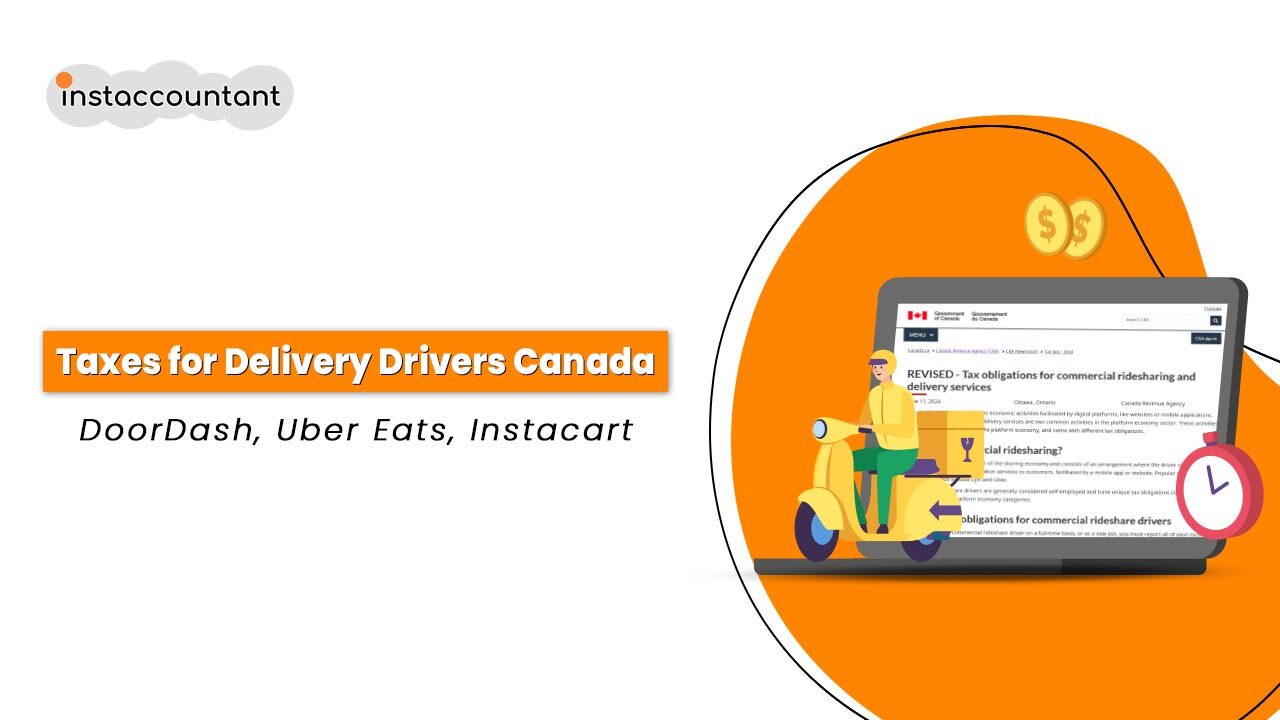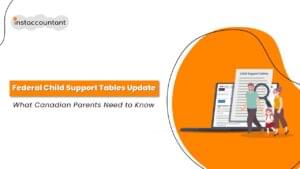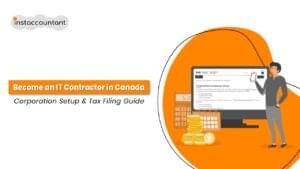Being a delivery driver in Canada for platforms like DoorDash, Uber Eats, SkipTheDishes, or Instacart come with lots of flexibility and additional income, and tax obligations that can become a bit confusing. Delivery drivers are considered self-employed independent contractors and can‘t file taxes like a regular employee. This means you must file your taxes differently, track your business-related expenses and understand how your earnings affect your overall tax situation.
This tax guide will teach you everything you need to know to file your taxes as an delivery driver in Canada, claim as many deductions as you can with confidence and be less surprised by the Canada Revenue Agency(CRA).
1. How Do I Report Income from DoorDash, Uber Eats, and Instacart?
- Delivery drivers are considered self-employed independent contractors, so your income is business income.
- You must report your income from all platforms on your T1 personal tax return using Form T2125 (Statement of Business or Professional Activities).
- You will report your gross income (all earnings before any fees or expenses are subtracted) and then list all of your business expenses. The result is your net business income, which is what you pay taxes on.
- Starting 2025, platforms also report your gross earnings directly to CRA, making accurate self-reporting critical.
- Keep payout statements or invoices for each platform.
2. Do DoorDash or Uber Eats Provide Tax Documents or Summaries?
-
No, these platforms do not issue T4 slips. A T4 is only for employees.
-
You receive earning summaries or end-of-year statements showing gross payments.
-
You must rely on these summaries and your own meticulous records to report your income and expenses.
-
Always download or request your annual income summaries from the platforms.
3. What Expenses Can I Deduct as a Delivery Driver in Canada?
You can deduct any reasonable expense incurred for the purpose of earning your delivery income. The most common and valuable deductions include:
-
Vehicle expenses: fuel, repairs, tires, insurance, lease payments, parking fees, tolls, car washes.
-
Capital Cost Allowance (CCA): depreciation on your vehicle’s value over time.
-
Phone and Internet: proportional business use of your cell phone and data plan.
-
Equipment: hot bags, phone mounts, chargers, GPS apps.
-
Supplies: wipes, sanitizer, cleaning.
-
Software and Apps: mileage trackers, navigation subscriptions.
-
Insurance: if specifically for your delivery business.
-
Other Expenses: Professional fees (e.g., for an accountant) and business insurance.
Keep receipts and records for all expenses claimed.
4. What is Capital Cost Allowance (CCA) and How Do I Use It?
-
Capital Cost Allowance (CCA) is Canada’s version of vehicle depreciation for tax purposes.
-
You claim a percentage of your vehicle’s value each year as a deduction.
-
The claim uses a set CCA class and rate typical passenger vehicles fall into Class 10 or 10.1 with a rate of 30%.
-
In the first year, only 50% of the cost is eligible (CRA’s half-year rule).
-
You calculate your business-use percentage (see Q6) and apply it to your CCA deduction.
-
CCA reduces your tax burden gradually but cannot create or increase a loss.
-
Consult a tax professional or CRA guidelines for exact calculations.
5. Can I Claim Vehicle Expenses Without Exact Kilometre Records?
-
CRA prefers detailed mileage logs to support business-use vehicle expenses.
-
If you don’t have exact records, you can estimate, but must be able to justify your estimate with evidence (delivery schedule, typical routes).
-
It is highly recommended to start tracking accurate mileage going forward.
-
Use mileage tracking apps approved by CRA (see Q12).
-
Poor or missing records increase audit risk and may lead to denied claims.
6. How Do I Calculate Business Use Percentage for Vehicle and Other Expenses?
-
Business use percentage = (Business kilometers driven ÷ Total kilometers driven) × 100%
-
Keep a detailed log of kilometers driven specific to delivery work.
-
Apply this percentage to all vehicle-related expenses (fuel, insurance, repairs).
-
The same principle applies to phone usage and other partly business-related expenses.
7. How Do I Report Tips from DoorDash and Uber Eats? Are Tips Taxed Differently?
-
All tips received, including cash and electronic, are taxable and must be reported as income.
-
Tips are added to your gross business income on your tax return.
-
Record and track cash tips separately if possible to ensure accuracy.
-
Tips do not receive special tax treatment; they are subject to the same self-employment tax rules.
8. Do I Need to Register for GST/HST as a Delivery Driver in Canada?
-
For delivery drivers (Uber Eats, DoorDash), GST/HST registration is only required if your total revenue exceeds $30,000 over four consecutive calendar quarters or in a single quarter.
-
Below this threshold, registration is optional.
-
Once registered, you must charge GST/HST on your delivery services and remit it to CRA.
-
Rideshare drivers (transporting passengers) must register and charge GST/HST regardless of earnings.
-
Voluntarily Registration allows claiming input tax credits on GST/HST paid on business expenses.
9. Can I Deduct the Cost of My Hot Bag, Phone Holder, or Car Charger?
-
Yes, equipment used exclusively for your delivery business such as insulated hot bags, phone mounts, chargers, and GPS devices are deductible as business expenses.
-
Keep receipts and records for these purchases.
-
Items used partly for personal purposes should be claimed proportionately.
10. Can I Claim Cell Phone and Data Plan Costs?
-
Yes, you can deduct the business-use portion of your cell phone and data plan.
-
Determine a fair percentage of use for business (e.g., time spent on navigation, accepting orders).
-
Keep bills and documentation to support your claim.
11. What are CPP Contributions and Do I Have to Pay These Myself?
-
As a self-employed individual, you must pay both the employee and employer portions of Canada Pension Plan (CPP) contributions.
-
CPP is calculated on your net self-employment income.
-
Make these payments when filing your taxes and consider making quarterly estimated tax payments to avoid penalties.
-
CPP contributions increase your future retirement benefits.
12. What are the Best Expense Tracking and Mileage Apps for Delivery Drivers?
-
Zoombooks: Canadian-focused app for real-time receipt scanning, expense categorization, and mileage tracking.
-
MileIQ, Everlance, TripLog: Popular mileage tracking apps compatible with CRA audit requirements.
-
Always keep digital records and use apps that generate reports that can be shared with accountants or CRA.
13. What Documents Should I Gather Before Tax Time?
Prepare the following documents and info before filing your tax return:
-
Annual income summaries/statements from all delivery platforms.
-
Receipts for all business expenses (fuel, equipment, supplies).
-
Mileage logs or app-generated reports.
-
Cell phone and data bills.
-
GST/HST registration and filing info (if applicable).
-
Previous year’s Notice of Assessment and RRSP contribution info.
-
Bank statements related to business income and expenses.
14. How Does Delivery Income Affect Taxes if I Also Have a Full-Time Job?
-
Income from delivery work is added on top of your employment income.
-
This may push you into a higher marginal tax bracket.
-
Taxes are not automatically withheld from your delivery income, so you should set aside 20-30% of this income for taxes, CPP, and potential GST/HST remittances.
-
You will file one combined tax return including all income sources.
-
Using CRA certified software or tax professional advice can help estimate your tax owing and avoid surprises at filing time.
15. Will Opening an RRSP or TFSA Help Reduce My Taxable Income?
-
RRSP contributions reduce your taxable income and lower taxes payable in the year contributed.
-
You can contribute up to 18% of your previous year’s earned income (up to annual limits).
-
TFSA contributions do not reduce taxable income but grow tax-free and withdrawals are tax-free.
-
Multiple income sources do not limit RRSP contributions but affect your contribution room.
-
Use CRA’s My Account or Notice of Assessment to check contribution limits.
16. Is It Possible to Claim Delivery-Related Expenses Without Receipts?
-
Officially, CRA requires supporting documents like receipts for expense claims.
-
Without receipts, claims may be denied or questioned in an audit.
-
If receipts are lost, alternative proofs such as credit card statements or bank records might help.
-
Keep digital copies of receipts organized using apps like Zoombooks throughout the year.
Conclusion
Following the expert recommendations in this guide will help ensure that you have a seamless, stress-free tax filing experience as an delivery driver in Canada and build a stronger financial foundation for your gig economy career.
Ready to reclaim your taxes? You can start with downloading a mileage tracking app, open up another bank account for your business and put a system in place where all of your receipts go. You will thank your future self.




